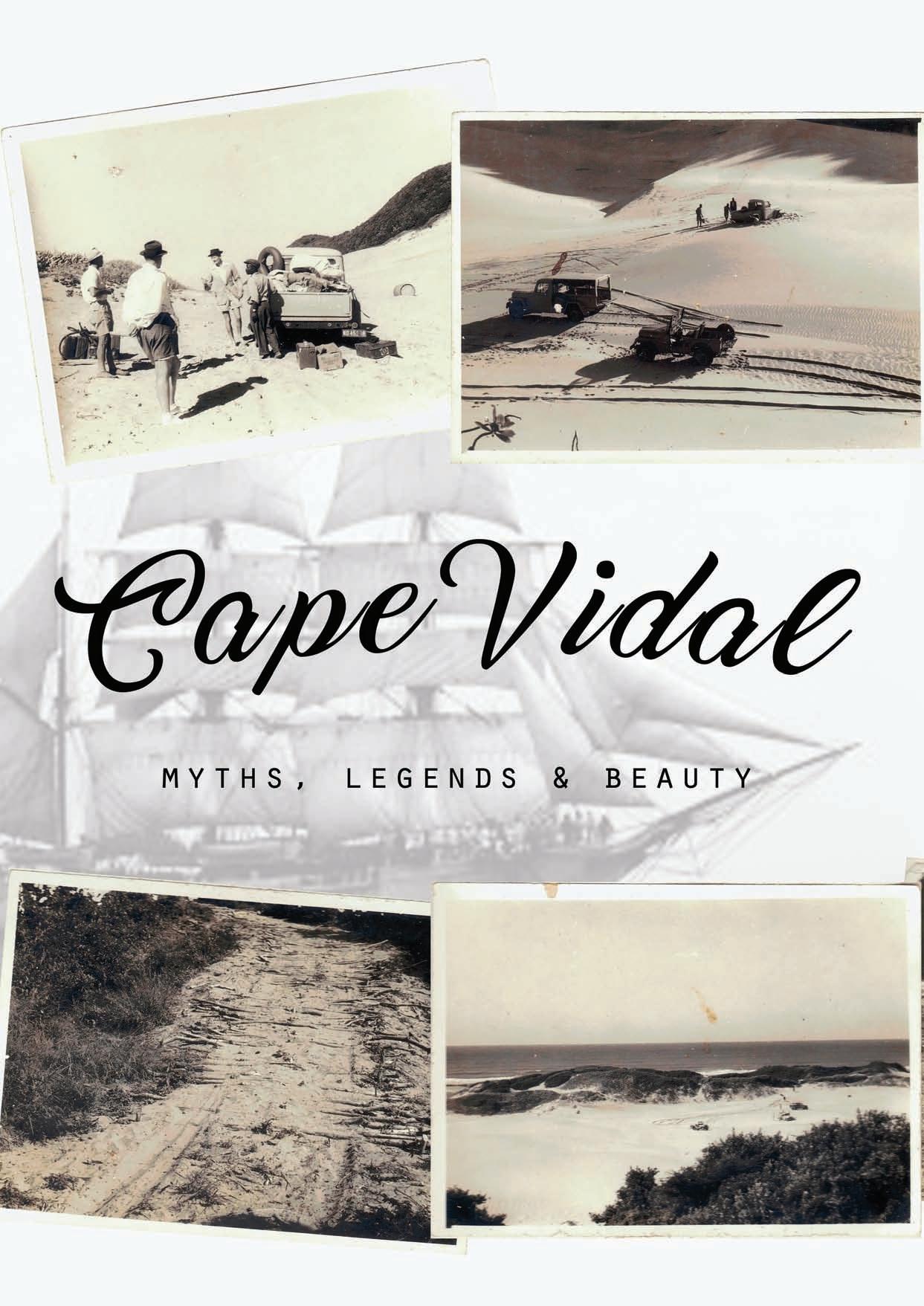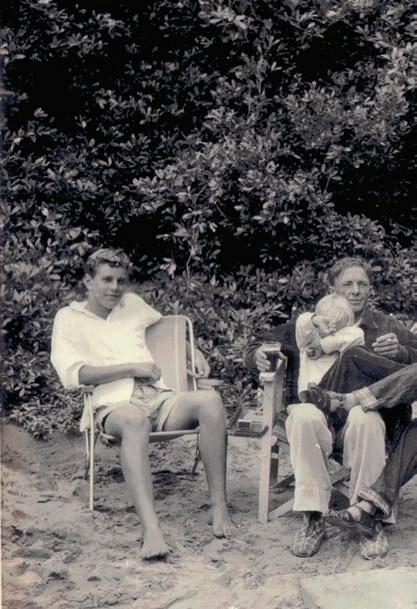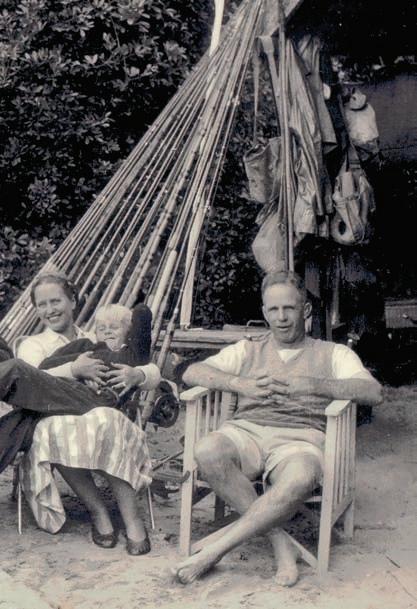
10 minute read
Cape Vidal Memories
Everything including the kitchen sink had to be taken with. Vehicles often got stuck in the soft dunes.
The feared ramp often had to be rebuilt.
Advertisement
Today this area of sand is covered with casuarina trees.
By Erwin Bursik O NE of man’s greatest attributes is the inherent freedom of choice. South African offshore anglers are particularly blessed with a wide variety of choice when it comes to ski-boat launch sites from the West Coast all around our coastline right up to Zululand’s border with Moçambique.
Each and every one of us has a specific launch area that ticks all the boxes — that’s our version of paradise. This easily tossed around term “paradise” has been attributed to an unbelievable number of fishing spots along our coastline, often leading to huge debate, but a man’s paradise is his and his alone to determine.
I was introduced to my particular version of paradise back in 1968 when I was persuaded to take an adventure trip with my friend Allan Cunningham to the wilds of Zululand’s northern coastline — a place named Cape Vidal to be exact. In 1968 Cape Vidal was far more remote and basic than the Cape Vidal of today. Back then it was the Department of Forestry’s domain and to get there from St Lucia involved a hairraising adventure on a treacherous 30km long 4X4 off-road mud bath that was not for the faint-hearted.
That was in the late 1960s when the forestry department was busy cultivating pine trees in the area. The heavy machinery they used created paths through the bush and we followed — or tried to — on a road that was extremely narrow especially where it was raised up over the large number of very swampy stretches. Following torrential summer rains this road challenged even the hardy Land Rovers we used at the time, and a tow cable was the most crucial accessory.
When we eventually reached an apparent turn off — although we still hadn’t seen a peep of the ocean — I saw a few very basic wooden shacks on a relatively flat plateau overlooking Lake Bhangazi. It was in one of these that Alan Cunningham and I were billeted as guests of Rod Tedder.
A short drive to the crest of the heavily wooded primary dune took us to a solitary cottage tucked away on our right flank. It belonged to a Zululand angling legend, Walter Van Rooyen. From there it was a steep descent past the present camping area and a very basic and small forestry camping area which much later became the freezer area. Then there was a track straight over the sand dune and onto the beach. It was this access ramp that I will never forget. It was a very steep descent towing a ski-boat, but easy, but it would have been nigh impossible to get back up had it not been for the resourceful ski-boaters who created a ramp with horizontally spaced wild banana trunks. If memory serves me correctly, Rod’s 16ft ski-boat Catfish powered by two motors was our means of getting to fish the offshore waters of Cape Vidal. On occasion we used my 30hp Penta outboard (ever heard of it?) which we carted from Durban for that purpose.
The Barracuda Shack, which I believed is still being used these days, was Rod’s dream, and Al and I helped him start building it when the weather was not conducive to launching a skiboat. When Rod and his partners in the Barracuda Shack eventually completed it we benefitted from our initial input by having two memorable visits with Rod and Dawn in the Barracuda Shack.
Cape Vidal ticked all my boxes for paradise — adventure, 4X4 off-roading, game viewing and, at the end, one of the most pristine semi-protected beach launches to be had. To top that, the ’cuda fishing just off the launch site satisfied our fish lust in terms of “whack


ing ’cuda”.
Al and I were far from the first to discover this magical fishing base. Back in the 1940s a group of real pioneers forged their way up to Cape Vidal to create — with permission from the forestry department and the blessing of the Zulu King of that period — a number of small fishing spots on the dunes and hill overlooking Cape Vidal Bay and the extensive reef that jutted out from the point in a north-easterly direction. It’s this reef that makes this the pristine bay and semi-protected launch site it will always be.
King Goodwill Zwelethini even went fishing at Cape Vidal in the 1970s when he and a small entourage accepted an invitation from Frikkie van der Westhuizen of Springs, and my late father-in-law Louis van Wyk, to go skiboat fishing there with them. The Walter van Rooyen shack was their base and, as the photographs overleaf show, it seemed King Zwelethini enjoyed his outing on Frikkie’s boat, Katonkel, catching a number of ’cuda and a sailfish.
Nearly there after driving 12 hours from Durban. Oh for a Warn Winch; 8 ply tyres did not help.
By Hilton Kidger

HISTORY One of the earliest mentions of Cape Vidal in the public realm was in January 1898 when the sailing ship Dorothea ran aground on the seaward side of Cape Vidal’s reef during a storm. Some stories hold that this craft was carrying the Kruger millions cemented around the base of its forward mast, but to date the area has not yielded any treasure. Apart from the anchor chain which is still visible at spring low tide as a reminder of the ill-fated Dorothea, what is left of her is buried just beyond the surf line. Whilst the crew is said to have boarded the lifeboats, no facts of their survival have been substantiated.
Living in that area required one to be tough, and one of these tough men was Reverend LO Feyling who established a mission above what is today known as Mission Rocks in the mid1890s.
A few years later when the Dorothea was wrecked at Cape Vidal this reverend used a self-built wagon with wheels made of the trunk of a

12 • SKI-BOAT March/April 2020 Please bear with me because what follows is mainly from faded memory, as my first trip to Cape Vidal was in 1953 when I was just five...
As far as I can recall from stories I was told around the campfire, my family’s connection with Cape Vidal started around 1948. Cape Vidal got its name from Lieutenant Alexander Vidal, captain of the Barracouta, but the area was commonly referred to as Bhangazi. Only in later years did Vidal become the common reference.
Dad had returned from military service in the desert and Italy. He arrived in a Catalina Flying Boat that refuelled at Catalina Bay (St Lucia) before flying on to Durban harbour. By chance my Mother was at the landing base when he stepped out — what a way to meet and greet after six years apart.
Once settled back in SA he was soon in touch with his good friends who were mostly in Zululand. They included Ernie Getgate, Colin Foxon, Norman Young, Coley Colenbrander and others. They formed a group called the Bhangazi Club and decided the ideal site for their base was on the beach in a sand dune with vegetation surrounding it.
From a canvas thrown over a centre beam, the camp was gradually improved to a single-storey shack with reed sides and eventually a doublestorey shack was created.
huge tree, to salvage 20 tons of timber from the wreck. He used the timber to build his mission house.
There are probably also bits of a German U-boat lying on the seabed off Cape Vidal. On 20 August 1943 two Catalina flying boats took off from Lake St. Lucia, hopped over the high sand bluff that runs up the coast from St Lucia, and depth charged a German submarine U–197 which was on the surface just off Cape Vidal. They completely annihilated the submarine before returning to land on Lake St. Lucia.
Information on when exactly Cape Vidal was opened to fishing enthusiasts after the Second World War is sketchy, but Eukie Kidger, father of Hlton Kidger — previous Commodore of the Durban Ski-Boat Club, must have been one of the first people to go fishing there. Hilton agreed to share some of his experiences of Cape Vidal as a young boy, where he enjoyed time at the Bhangazi Club shack behind the big sand dune right opposite the Cape Vidal bay ....

The Kidger family in the early days at Vidal. Note that only cane rods and Scarborough reels were used.
My dad had the Willys Jeep franchise through a company called Stanley Motors. Dad was the General Manager and he had three 4x4 Jeeps kitted out for Cape Vidal. I can still vividly remember our departure from our home at Morningside Road with me strapped in with a rope in the CJ 5 Jeep that did not have any doors! My dad drove that vehicle. The other Jeeps were a truck with canopy — a “hoender hok” holding 12 live chickens was bolted to the top — and a Jeep Station wagon. These two vehicles were driven by Enos, Dad’s driver, and a friend.
The journey took all day with serious sand beginning at Matubatuba. The distance from St Lucia to Cape Vidal was about 30km but it took about three hours to travel that distance. I spent more time with my rear end in swamp water than out of it! Remember there was no portable refrigeration in those days. As ice was a major need, but could not be made on site, my dad would order from Durban Cold Storage and they sent the ice up by train to Matubatuba. They would send up solid blocks of ice packed in saw dust. These were stored in a slatted truck so the air would pass through and act as a coolant. If I remember correctly the trip took three days. Enos was then despatched with a Jeep to collect the ice. It took him a full day to collect it and return.
Some of these trips my dad did, involved him being away for weeks at a time and back then there was no easy way of staying in contact with those back home. Any post for my dad was sent to Mervyn Guild at St Lucia, who had a private plane. He would then drop post, newspapers etc from the sky after buzzing the camp. If he was passing by at spring low tide he would land on the beach, have a chat and a swim and then depart, taking with him any written communication from my dad which would then be sent on to my mother. Different times indeed.
Another difference I remember from my early visits compared to now is that before the trees were planted on the dunes behind the shack the bay was always deep and never sanded up. The easterly that prevailed in the area washed the sand over the dunes and into the forest, and in so doing always ensured the bay was scoured out. As a result the fishing in the bay was outstanding. Often as a youngster I would, whilst fishing for wave garrick, watch sharks patrolling inside the reef and circling around the bay. In those days mullet, shad, wave garrick, black tail and kingfish were all there in abundance.
Cape Vidal has changed dramatically since the 1950s, and nowadays there are log cabins for hire and a fully set up camp site with a small shop, and certainly many more people visit there, but one things hasn’t changed — it’s still paradise in my book. If readers have specific memories and photos of their own visits to Cape Vidal prior to 1980 that they would like to share they’re welcome to email them to <sheena@mags.co.za> before 23 March. The first ‘ski-boat’ to be launched at Vidal was used to take anglers’ big baits out into the deep water of the bay.



Basic but comfortable.












